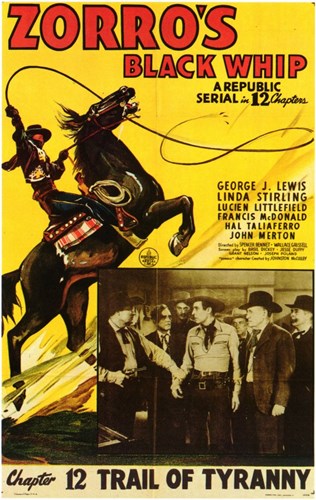
Zorro's Fighting Legion is a 1939 Republic Pictures film serial consisting of twelve chapters starring Reed Hadley as Zorro and directed by William Witney and John English. The plot revolves around his alter-ego Don Diego's fight against the evil Don Del Oro.

S O S Coast Guard is a 1937 Republic film serial. It was the seventh of the sixty-six serials made by Republic. The plot concerns the mad scientist Boroff attempting to sell a superweapon to the highest bidder, opposed by Coast Guard Lieutenant Terry Kent, for both personal and professional reasons.

Zorro's Black Whip is a 1944 12-chapter film serial by Republic Pictures starring Linda Stirling. The film was made after the 1940 20th Century-Fox remake of The Mark of Zorro in order to capitalize on it. Republic was not able to use the character of Zorro himself, however, and despite the title, the hero(ine) is called The Black Whip throughout.

The Fighting Devil Dogs (1938) is a 12-chapter Republic movie serial starring Lee Powell and Herman Brix, the latter better known by his later stage name, Bruce Bennett. It was directed by William Witney and John English. While not often considered a great serial, as it contains much stock footage and two recap chapters, it is famous for its main villain, the Lightning—the first costumed supervillain. There is some speculation that George Lucas used the Lightning as a template for Darth Vader.

The Tiger Woman (1944) is a 12-chapter film serial by Republic Pictures starring Allan Lane and Linda Stirling. The serial was re-released in 1951 under the title Perils of the Darkest Jungle and, in 1966, it was edited into the 100-minute Century-66 film Jungle Gold.

Dick Tracy's G-Men (1939) is a 15-Chapter Republic movie serial based on the Dick Tracy comic strip by Chester Gould. It was directed by William Witney and John English.

Darkest Africa (1936) is a Republic movie serial. This was the first serial produced by Republic Pictures and was a loose sequel to a Mascot Pictures serial called The Lost Jungle, also starring Clyde Beatty. Mascot, and other companies, had been taken over in 1935 by Consolidated Film Laboratories and merged to become Republic. Producer Nat Levine was formerly the owner of Mascot Pictures.

The Vigilantes Are Coming is a 1936 American Republic film serial directed by Ray Taylor and Mack V. Wright. It was the third of the sixty six serials made by Republic Pictures.

The Painted Stallion is a 1937 American Western film serial from Republic Pictures. It was the sixth Republic serial of the sixty-six made by that company. Western serials such as this made up a third of the serials from Republic, a studio that was also heavily involved in making B-Western feature films at the time.

The Lone Ranger is a 1938 American Republic Pictures movie serial based on The Lone Ranger radio program. It was the ninth of the sixty-six serials produced by Republic, the fourth Western and the first Republic serial release of 1938. The following year a sequel serial The Lone Ranger Rides Again was released. The fifteen chapters of the serial were condensed into the film Hi-Yo Silver, which was released in 1940.

Dick Tracy Returns (1938) is a Republic Movie serial based on the Dick Tracy comic strip. It was the eleventh of the sixty-six serials Republic produced and a sequel to the 1937 serial Dick Tracy, with Ralph Byrd reprising his role as the title character. It was successful enough that two further sequels were released in 1939 and 1941, and Byrd become so connected with the character he went on to play him in a subsequent television series.

The Lone Ranger Rides Again is a 1939 American Republic serial. It was a sequel to Republic's 1938 serial The Lone Ranger, which had been highly successful, and the thirteenth of the sixty-six serials produced by Republic.

Secret Service in Darkest Africa is a 1943 Republic serial. It was Republic's 30th serial, of the 66 produced by the studio.

Son of Zorro is a 1947 American Western film serial from Republic Pictures. It was the 43rd of the 66 serials produced by that studio. The serial was directed by Spencer Gordon Bennet and Fred C. Brannon. George Turner starred as a descendant of the original Zorro in 1860s United States.

Jesse James Rides Again is a 1947 American Republic Western film serial.

Ghost of Zorro is a 1949 Republic Movie serial. It uses substantial stock footage from earlier serials, including Son of Zorro and Daredevils of the West. This film was shot in Chatsworth, Los Angeles.

Don Daredevil Rides Again (1951) is a Republic Movie serial. It makes heavy use of stock footage from Republic's previous Zorro serials. The character of Don Daredevil was created for this serial as the rights to Zorro belonged to Disney by 1951.

Battling with Buffalo Bill is a 1931 American pre-Code Western serial film directed by Ray Taylor and starring Tom Tyler, Lucile Browne, William Desmond, Rex Bell, and Francis Ford.

Custer's Last Stand is a 1936 American film serial based on the historical Custer's Last Stand at the Little Bighorn River. It was directed by Elmer Clifton, and starred Rex Lease, William Farnum and Jack Mulhall. It was produced by the Poverty Row studio Stage & Screen Productions, which went bust shortly afterwards as a victim of the Great Depression. This serial stars many famous and popular B-Western actors as well as silent serial star Helen Gibson playing Calamity Jane, Frank McGlynn Jr. as General Custer, and Allen Greer as Wild Bill Hickok.

The Last Frontier is an American Pre-Code 12-chapter serial, distributed by RKO Radio Pictures in 1932. The story was based on the novel of the same name by Courtney Ryley Cooper.













